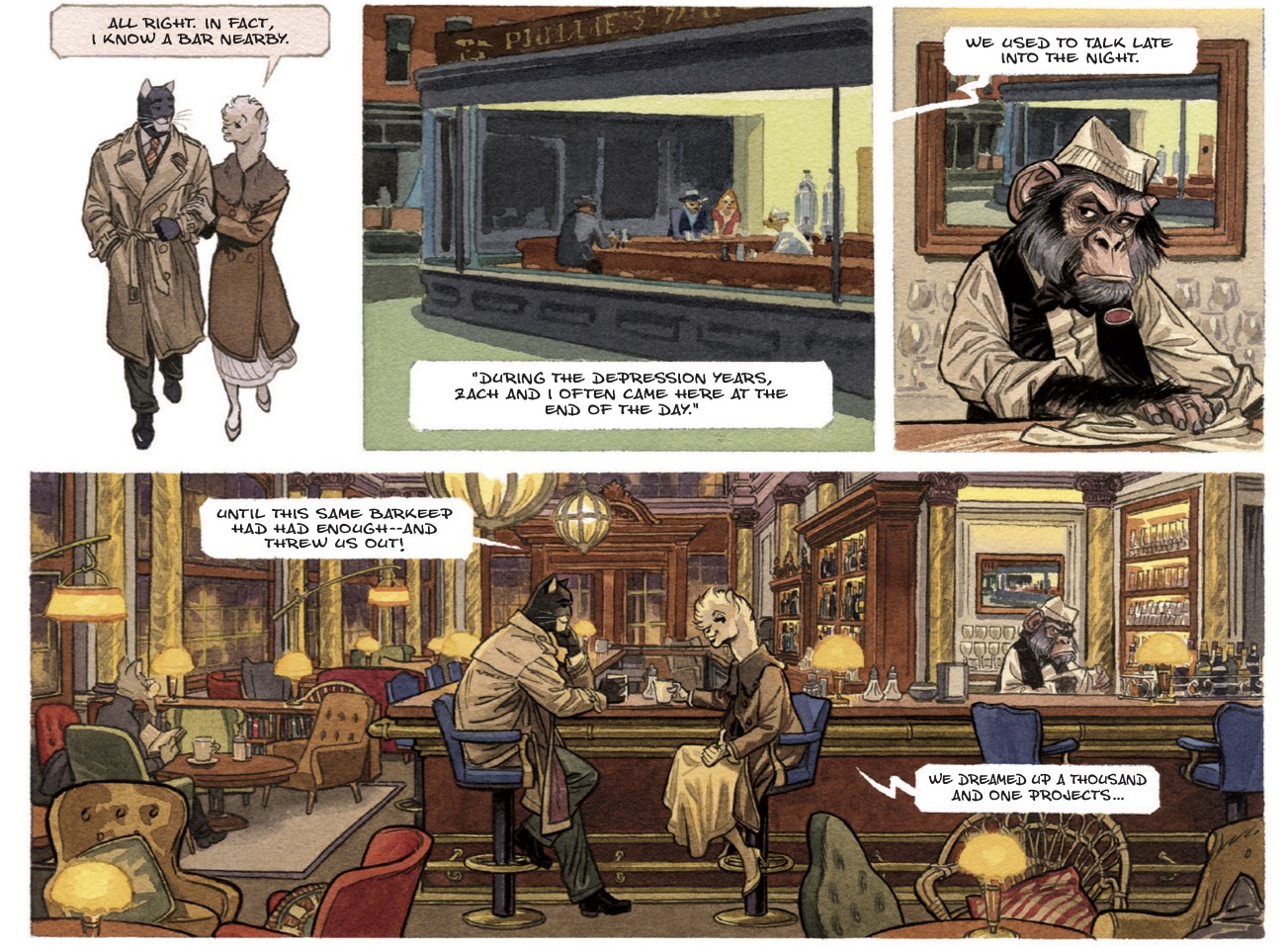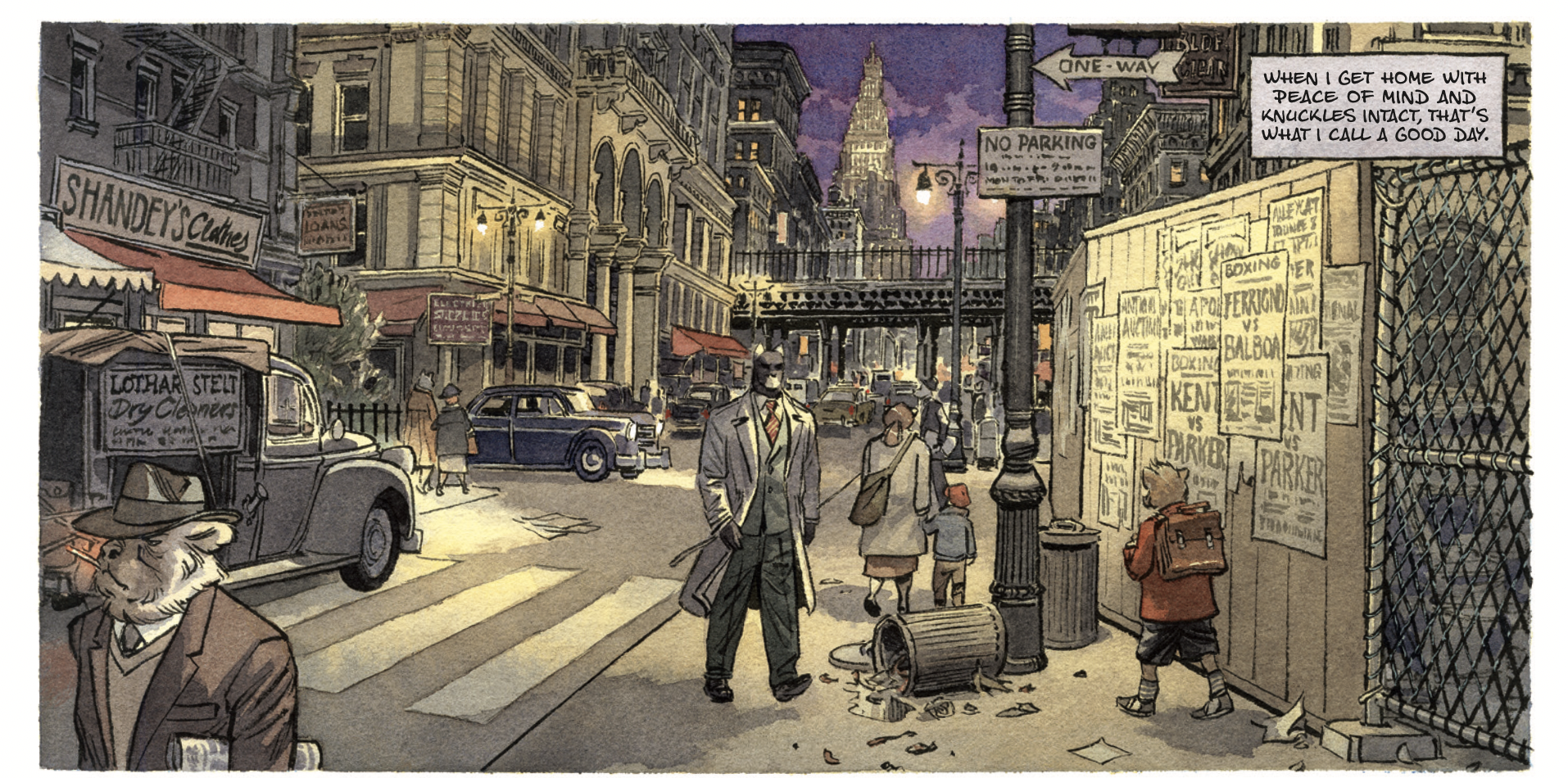Blacksad is back after almost eight years, and it’s just what we need. There’s plenty of twists and intrigue in this Part One of a new storyline to keep the pages turning. You’ll want to do that slowly however, to give yourself plenty of time to take in the gorgeous Juanjo Guarnido artwork. Although the anthropomorphic animal detective action is set again back in the 1950s, it’s just the right tone of noir for our times too. With all the world has been through lately, I don’t think we could handle something as grim as 2003's Artic Nation story again, with its rampant racism, brutal violence, and huge capacity for suffering. But some of the same topics recur from the previous books, as well as from real life - power, corruption, greed, the plight of the worker.
Guarnido and co-creator Juan Díaz Canales mean to go big, as evidenced by their kicking off the story with a double dose of the Bard - a performance of The Tempest at Shakespeare in the Park plays out while Blacksad’s inner narration references As You Like It. And although this is the America–New York City, to be precise–of 70 years ago, the action is just as relevant to today as police brutality rears its ugly head on the third page. Before the cops rush in, a packed crowd are enjoying a pleasant afternoon watching the play. Private eye Blacksad is looking sharp but casual in a green suit, sitting next to sidekick Weekly on the grass. That’s right, Weekly’s back, and he's an integral source of the action, as his love for the foxy Rachel Zucco leads him to take his journalistic endeavors up a notch. His fearlessness soon has him following “master builder” Solomon around town to get a story. The wordplay is clever throughout They All Fall Down, with the name Solomon of course being a reference to the biblical King who built the First Temple of Jerusalem, as well as Robert Moses, New York's infamous public official, who was involved in city planning from 1924-1963, the same time period depicted here.
At the end of the Dark Horse edition, Diana Schutz provides notes on the translation, offering insight into the process and what the original 2021 Spanish- and French-language volumes contained. Here, in the English version, animal words such as ‘ferret’, ‘bat’, ‘buffalo’, etc. offer cool double meanings though the anthropomorphic cast. The best is a clever pun on New York City’s five boroughs, with the bowels of the city, where moles work on the subway tunnels, being dubbed ‘the burrow’. There are visual references too. Throughout the book, we see the powerful quite literally above the rest, on top floors of buildings and high up in the sky, while both the oppressed and the villains who carry out the elite’s dirty work are, for the most part, underground. Panel four on page 40 is a straight-up reproduction of Edward Hopper’s "Nighthawks", used to set the scene for where Blacksad is meeting Iris Allen, head of the Shakespearean theatre company, for a drink. "Nighthawks" shows the outside of a bar, but it is two panels later, with Guarnido's depiction of the same bar's interior, that is one of the compositional highlights of the book. Soon, on page 47, a mousey Sammy Davis Jr. is entertaining a crowd with "The Birth of the Blues", singing atop a piano.
Speaking of Iris, she is a shining example of Guarnido’s masterful artwork. Besides the detail involved in his cityscapes and crowd scenes, Guarnido is great at conveying tones of emotion and character. Right up front we get a sense of the crowd’s pleasure turning to anger as the police attempt to bust up their enjoyment of The Tempest. Throughout the story there is much fear and sadness–as well as downright shock and horror–to be felt from the characters' facial expressions. There’s humor too, as Rachel convinces a hopeless Weekly to rehearse Romeo and Juliet with her, much to Iris' consternation. In a character such as Iris Allen, a famed director and acting coach, we really get a sense of who she is from Guarnido’s drawing: all the many facets that people (or animals behaving as people, as the case may be) contain. She has the air of someone with great authority; strong, but also kindly. She doesn’t suffer fools gladly, but is full of grace. All this is communicated in great part by how she appears on the page.
And what of our hero John Blacksad? He’s on the lookout for work, has an office in a rough part of town, and is admittedly a bit out of shape. He takes a job to prevent a murder which sends him undercover down to ‘the burrow’. It is in these depths where we encounter what life is like for the working class rodents - creatures who don’t take kindly to a cat entering their midst. There is also a crocodile seen amongst these pit workers, which is perhaps a reference to the NYC legend of children receiving baby alligators for Christmas, only to flush them down the toilet where they would grow up in the sewers.
Blacksad himself runs the gamut of emotions–there’s a touching scene with him encountering a poor-yet-enterprising young raccoon– and with all that’s carrying us into the second volume of the book, it seems there will be many more to come. There’s a mysterious gull lying in an incubator in Bellevue Hospital that we still don’t know much about. Weekly’s assignment has become, shall we say, precarious. And with the book ending on a performance of Macbeth, the third Shakespeare play in the story so far, could this be some heavy foreshadowing?









